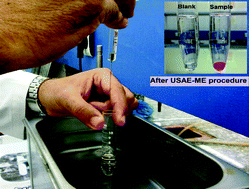Application of ultrasound-assisted emulsification microextraction for spectrophotometric determination of trace amounts of antimony(v) in drinking water samples using rhodamine B
Abstract
Ultrasound-assisted emulsification microextraction (USAE-ME) procedure has been applied for preconcentration and spectrophotometric determination of antimony(V) in water samples. The method is based on the ion-pair formation of hexachloroantimonate with rhodamine B in acidic medium, followed by USAE-ME of the formed ion-pair into fine droplets of the organic phase for spectrophotometric detection. Experimental parameters for both the spectrophotometric reaction and the USAE-ME procedure have been optimized. Under the optimum conditions, the calibration graph was linear over the range 5.0–300.0 ng mL−1 of Sb(V) (R2 = 0.998). The detection limit (3Sb) and preconcentration factor were 0.6 ng mL−1 and 40, respectively. The relative standard deviation (RSD) for five replicate determinations of Sb(V) at 100.0 ng mL−1 concentration level was calculated to be 2.4%. The proposed method has been successfully applied to the determination of antimony(V) in different water samples and good spiked average recovery of 98.3% was obtained.


 Please wait while we load your content...
Please wait while we load your content...